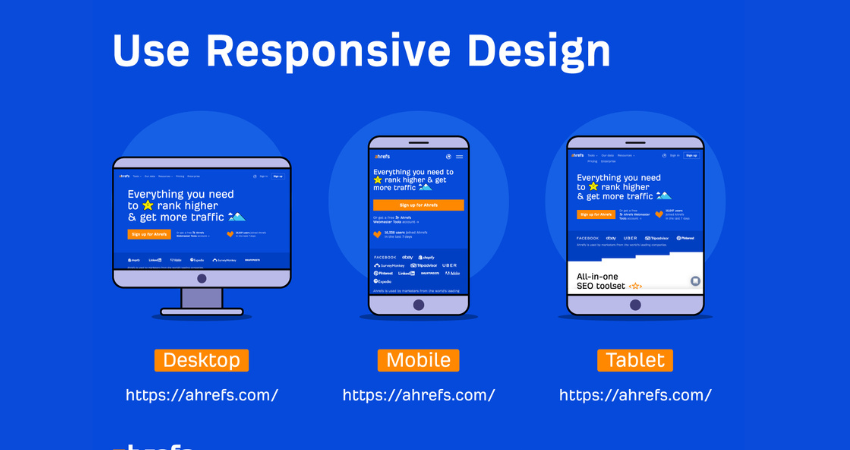Currently rolling into 2025, mobile-first indexing remains an abiding trend influencing the search engines’ methodology in ranking websites. Google had stated some time ago that mobile usability would become one of the major ranking factors, and that emphasis has only grown stronger since then. Mobile-first indexing indicates that Google mostly uses the mobile version of a site’s content to index and rank pages. Thus if your website does not pass the mobile test, then it is truly behind in terms of SEO performance.
Apart from being a best practice, mobile optimization has become a necessity, considering the growing number of users browsing the web using smartphones. Recent studies show that more than 70% of internet traffic comes from mobile devices. Thus, the new trend demands the search engines to consider sites that load fast, look great, and deliver high performance on smaller screens. Google algorithms, now responding to this demand, have therefore laid great emphasis on the mobile responsiveness of websites in determining their rankings in SERP.
If the site performs poorly in loading or rendering on a mobile device, it severely affects the user experience and thus, visibility in search. Mobile optimization, on the other hand, also aligns with trending features such as voice search and location search, thus influencing how businesses get discovered online.
What Mobile-First Means for SEO in Practice
It will therefore have an impact not only on screen and layout but also on how search engines crawl and interpret the structure, content, and usability of your website. If the mobile variant is missing anything found on the desktop, such as structured data, meta tags, or even total content, then there is a greater chance that your site may be penalized in rankings. SEO for 2025 is all about making sure that content display and on-page elements remain consistent no matter what device is being used.
Another aspect could be speed. Instant loading is the expectation of mobile users, and search engines reward pages that provide fast and seamless functionality. Developers, then, together with marketers, shall on one hand push for rich content while on the other hand ensuring performance optimization through responsive design, image compression, and optimized coding practices. Mobile-friendly design is no longer an exception; it is a prerequisite for any kind of strategic approach concerning SEO.
Why User Experience on Mobile Devices Matters

Meeting User Expectations in 2025
A good online experience today demands to be fast and sweet in every way, especially on mobile. As digital behavior becomes different, people tend to interact with content differently on different devices such as mobile and desktop. By 2025, people expect sites to load almost instantly, include touch-friendly interfaces, and have clear navigation structures. When sites fail to meet these end-user expectations, there is a high likelihood of bounce-back, thus making bounce rates send negative signals to search engines.
A mobile-friendly site is not just one that “works” on a phone but feels built for it. Fonts must be read without zooming, buttons must be tippable without much trouble, and key content must be available within a couple of seconds. Failure to meet these user requirements lowers trust, decreases engagement, and could cause a serious disaster for your SEO.
User experience (UX) now directly relates to ranking factors such as Core Web Vitals: starting from measuring how fast a content is loaded, the establishments and stability of the layout in load, and responsiveness to the user’s interaction with the site. Hence, optimization of these factors considering mobile becomes a priority for businesses determined to either sustain or grow their online presence.
Mobile Behavior Influences Content Strategy
You need to do content that really considers a mobile user. Long paragraphs, small text, and difficult navigation are things impossible to engage in on a phone. The content in the website should be concise, actionable, and so structured for easy scanning. It does not mean lesser values, but it increases clarity.
In the year 2025, a lot of users would see businesses because of social media or through a quick Google search on-the-go during the time. Being a mobile-first user, this means that the content of your site should mainly answer queries quickly, clearly calls to action, and fit all screen sizes. Content layout must allow reading without any interruption, and all the visual assets must support, not slow down, the experience.
In terms of content strategy to a mobile UX principle, it should flow from search discovery to site engagement, and that has to happen to improve your SEO rankings and conversion opportunities.
Technical Optimization for Mobile SEO
Responsive Design and Mobile Architecture
Responsive web design is one of the cornerstones of mobile SEO. It ensures that a site automatically launches into varying screen sizes or device types. By 2025, responsive design is essentially expected, not just required. A single URL with a unified HTML code across devices is what Google favors, for this makes life simpler for crawling and indexing.
A mobile-friendly architecture encompasses, among others, easy navigation and easily accessible menus with pop-ups kept to a minimum. These characteristics ensure that users, and search engines for that matter, will find navigation easy on your site. The mobile architecture must strive for simplicity and efficiency, hence maintaining compatibility with accessibility standards. To avoid any confusion during the indexing process, the mobile variant of your site should carry similar content as on desktop and vice versa with metadata.
Moreover, when you optimize your site structure for mobile, you can diminish errors such as unplayable content or blocked resources, which can affect your SEO standing. Technical audits using the likes of Google Search Console can help you react swiftly to site issues that need fixing, thus ensuring that your performance remains in excellent condition for the mobile search arena.
Improving Mobile Page Speed and Load Times
In 2025, page speed has become an SEO factor that goes without saying. On a mobile platform, it becomes increasingly important. Users can hardly afford to sit and wait for a page to load slowly, especially in mobile browsing. With tools like Google Page Speed Insights and Lighthouse, site owners can assess and optimize slow mobile load times which are usually affected by factors like unoptimized images, larger scripts, and server response issues.
Some of the speed-enhancing suggestions available are lazy loading, good caching mechanisms, and limit third-party scripts. Compressing CSS and JavaScript files also works to an extent, increasing speed without compromising design. The choice of hosting and content delivery networks (CDNs) significantly affects performance, mainly when users are in different geographic locations.
A faster site translates to higher user satisfaction and a signal to search engines that gives your site a high value for their users’ experience, thereby positively impacting the rankings.
Mobile-Friendliness and the Future of Search

The Role of Voice Search and AI Assistants
Mobile usage rises along with dependence on voice assistants such as Siri and Google Assistant, not forgetting Alexa. Queries made by voice search are usually longer and more conversational compared to text-based searches. Such optimizations for websites will catch these queries because they would be structured to respond fast and present their interfaces as user-friendly.
Voice optimization will involve creating content for featured snippets, incorporating conversational language, and focusing on local SEO. Websites that are mobile-friendly and easily load fast and give direct answers to voice questions find themselves faring better in this case. Businesses that understand and respond to this transformation will have a much higher visibility in the increasingly voice-driven search environment of 2025.
Preparing for a Mobile-First Future
As AI, AR, and wearable tech continue to advance at a blistering fast pace, the importance of mobile SEO will only increase. Users will include those using smartwatches to search, as well as people using augmented reality browsers to interact with websites-Mobile compatibility goes above and beyond just smartphones.
Be always ahead in assessing the mobile readiness of your website. Continuing education, testing, and iteration is a must for businesses in order to position their digital strategies against technological trends. From design to content to technical optimization, mobile-friendliness will forever be in the heart of future-proof SEO practices.
Conclusion
Mobile-friendliness is no longer an advantage for SEO; in fact, it is becoming more and more necessary as a trend in 2025. All signs are pointing here, from mobile-first indexing by Google to changing user behaviors and the rapid advancements of technology. The reality is that optimizing a website makes it more visible in searches, boosts engagement among users, and builds a company better for future growth. Indeed, focus on responsive, speedier page loads, and giving a great experience for all mobile users is not about pleasing the algorithm. In the long run it is about adding value for real people, using your site every single day. As search evolves, so does the visibility of your business in a very real, relevant and competitive space in digital commerce.